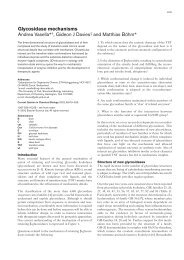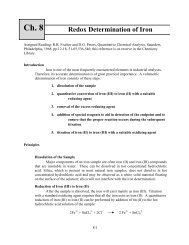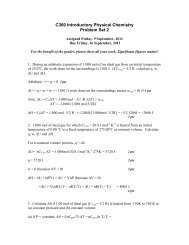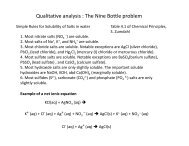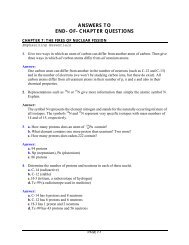ANSWERS TO END-OF-CHAPTER QUESTIONS
ANSWERS TO END-OF-CHAPTER QUESTIONS
ANSWERS TO END-OF-CHAPTER QUESTIONS
You also want an ePaper? Increase the reach of your titles
YUMPU automatically turns print PDFs into web optimized ePapers that Google loves.
Answer:<br />
a. These batteries are lighter and less toxic than the lead-acid batteries.<br />
b. The overall reaction is:<br />
Zn(s) + Ag2O(s) ⎯→ ZnO(s) + 2 Ag(s)<br />
The oxidation half-reaction is: Zn(s) + O 2– (aq) ⎯→ ZnO(s) + 2 e –<br />
The reduction half-reaction is: Ag2O(s) + 2 e – ⎯→ 2 Ag(s) + O 2– (aq)<br />
36. The battery of a cell phone discharges when the phone is in use. A manufacturer, while<br />
testing a new “power boost” system, reported these data.<br />
Time, min.sec Voltage, V<br />
0.00 6.56<br />
1.00 6.31<br />
2.00 6.24<br />
3.00 6.18<br />
4.00 6.12<br />
5.00 6.07<br />
6.35 6.03<br />
8.35 6.00<br />
11.05 5.90<br />
13.50 5.80<br />
16.00 5.70<br />
16.50 5.60<br />
a. Prepare a graph of these data.<br />
b. The manufacturer’s goal was to retain 90% of its initial voltage after 15 minutes of<br />
continuous use. Has that goal been achieved? Justify your answer using your graph.<br />
Answer:<br />
a.<br />
PAGE 8-12



